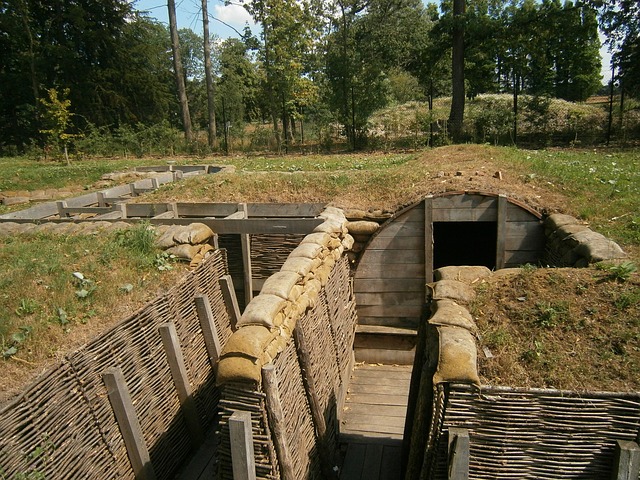By Tim Lambert
In the First World War, both sides dug trenches and laid barbed wire in front of them. It meant that the defending side was at a great advantage. They were protected by their trenches while the attacking side, advancing on foot were very vulnerable to fire from rifles and machine guns. It was impossible to advance without very heavy casualties. As a result, neither side could gain a decisive advantage, and a stalemate set in.
First World War soldiers also fought with grenades and in 1915 the Germans introduced the flamethrower.
In the First World War, each side dug 3 lines of trenches one behind another. First, there was the front-line trench. Behind it was a support trench and finally a reserve trench. The trenches were linked together by other trenches. Normally trenches were dug in a zig-zag fashion rather than being straight so if enemy soldiers got in they could not fire along their length. At intervals along the trenches were machine-gun posts.
Before infantry tried to advance across no-mans-land between their trenches and the enemies an artillery barrage was fired. However, the bombardments were never very effective. They also served as a warning to the enemy that an attack was coming. The artillery bombardment would also churn up the soil in no-mans land. If it rained the earth turned into a sea of mud. Furthermore the night before an attack the soldiers had to cut gaps in their barbed fire so they could advance. That too showed the enemy that an attack was coming.
In 1915 the Germans used gas on the western front. At first, they used chlorine. However, troops were supplied with gas masks. Finally, in 1917 the Germans used mustard gas. Yet gas failed to break the stalemate.
Both sides tried to destroy the enemy trenches with mines. They dug tunnels under the enemies’ trenches and then detonated mines to obliterate them. However, both sides used listening devices to warn them if the enemy was trying to do that. If they detected sounds of digging they would dig their counter-tunnels into the tunnels the enemy was making. A fight would then take place underground.

However, it was the British invention, the tank that finally broke the deadlock. Tanks were first used on 15 September 1916 at the Battle of the Somme. However, they had little effect and many broke down before they even reached British lines. Nevertheless, Haig the commander of the British army was an enthusiastic supporter of tanks, and they were first used in large numbers at the Battle of Cambrai in November 1917. They proved to be a success. Tanks also proved to be very useful in the Allied offensive of August 1918.
U-boats
One new weapon in the First World War was the U-boat. People had experimented with submarines since the early 17th century but it was the invention of the diesel engine that made submarines feasible. The British launched their first submarine in 1901 but during the First World War German U-boats sank hundreds of Allied merchant ships.
During the First World War, the Allies introduced weapons to counter the U-boat menace. The British invented sonar in 1915. Some U-boats were destroyed by mines and from the end of 1915 by depth charges. The Allies also used Q-ships (merchant ships with disguised guns). Furthermore, from April 1917 allied ships traveled in convoys with escorts. By 1918 aircraft technology had improved so much that planes could escort convoys. Despite all these measures submarines continued to play an important part in naval warfare.
Meanwhile, in 1915 the Germans began using Zeppelin airships to bomb British cities. However, Zeppelins proved very vulnerable to fire from planes and anti-aircraft guns.
At the beginning of the First World War, aircraft were used to observe the enemy. During the war aircraft technology changed rapidly. However, the war ended before aircraft could play a decisive part.
In July 1918 aircraft took off from HMS Furious and bombed Zeppelin sheds although aircraft carriers came too late to play a significant part in the First World War.